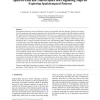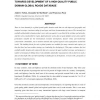20 search results - page 1 / 4 » Organization of Data in Non-convex Spatial Domains |
SSDBM
2010
IEEE
13 years 10 months ago
2010
IEEE
We present a technique for organizing data in spatial databases with non-convex domains based on an automatic characterization using the medial-axis transform (MAT). We define a t...
ADBIS
2000
Springer
13 years 9 months ago
2000
Springer
We consider queries which originate from a mobile unit and whose result depends on the location of the user who initiates the query. Example of such a query is How many people are ...
CGF
2010
13 years 5 months ago
2010
Spatiotemporal data pose serious challenges to analysts in geographic and other domains. Owing to the complexity of the geospatial and temporal components, this kind of data canno...
DATASCIENCE
2006
13 years 5 months ago
2006
There is clear demand for a global spatial public domain roads data set with improved geographic and temporal coverage, consistent coding of road types, and clear documentation of...
ICIP
2001
IEEE
14 years 6 months ago
2001
IEEE
DCT-based digital video coding standards such as MPEG and H.26x have been widely adopted for multimedia applications. Thus video processing in the DCT domain usually proves to be ...


